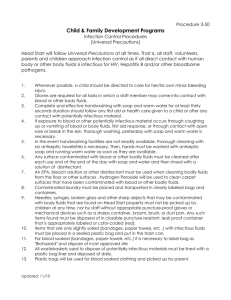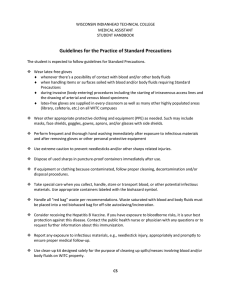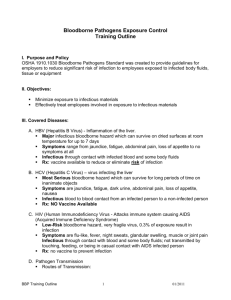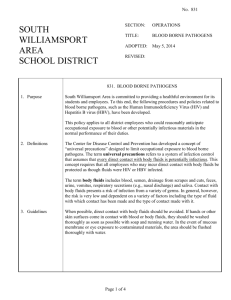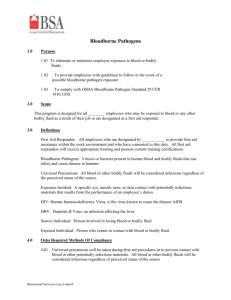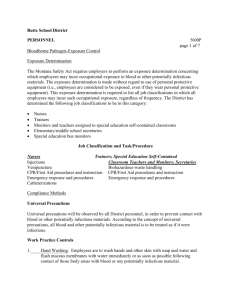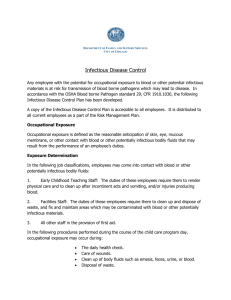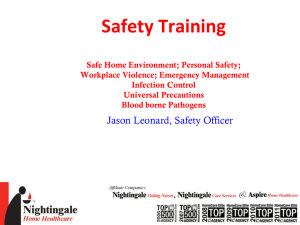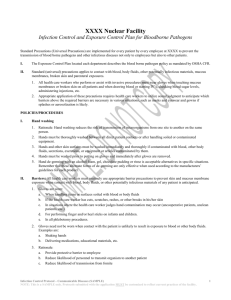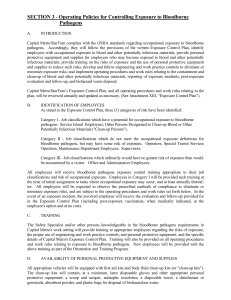Ambercares-Infection-Control-Definitions-HANDOUT
advertisement
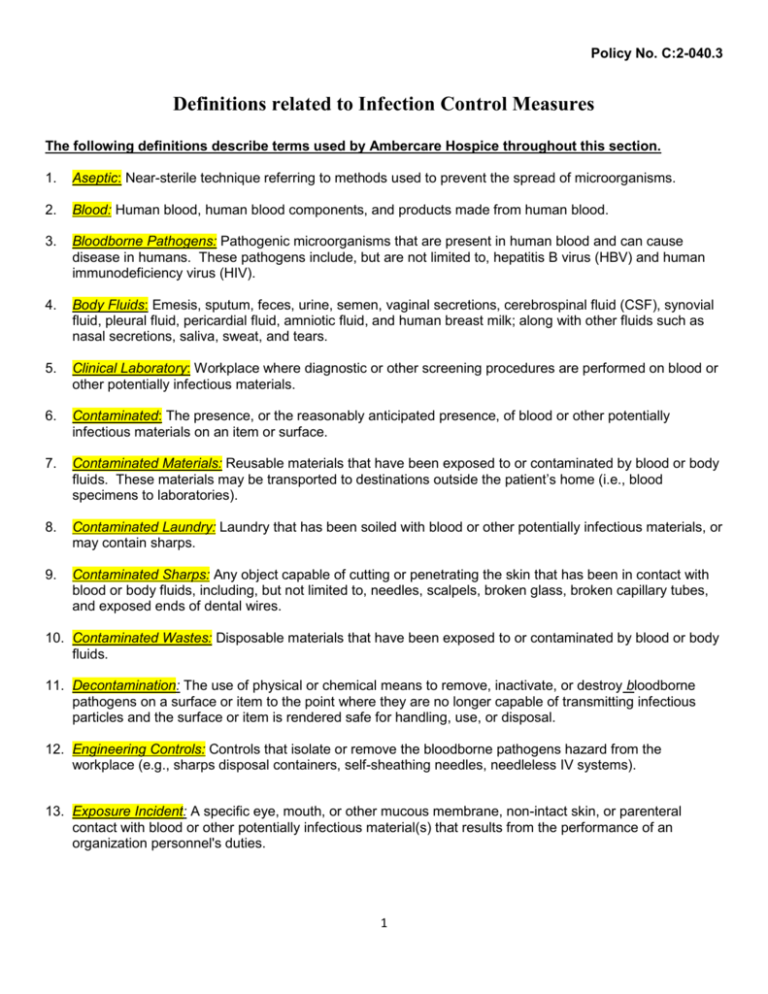
Policy No. C:2-040.3 Definitions related to Infection Control Measures The following definitions describe terms used by Ambercare Hospice throughout this section. 1. Aseptic: Near-sterile technique referring to methods used to prevent the spread of microorganisms. 2. Blood: Human blood, human blood components, and products made from human blood. 3. Bloodborne Pathogens: Pathogenic microorganisms that are present in human blood and can cause disease in humans. These pathogens include, but are not limited to, hepatitis B virus (HBV) and human immunodeficiency virus (HIV). 4. Body Fluids: Emesis, sputum, feces, urine, semen, vaginal secretions, cerebrospinal fluid (CSF), synovial fluid, pleural fluid, pericardial fluid, amniotic fluid, and human breast milk; along with other fluids such as nasal secretions, saliva, sweat, and tears. 5. Clinical Laboratory: Workplace where diagnostic or other screening procedures are performed on blood or other potentially infectious materials. 6. Contaminated: The presence, or the reasonably anticipated presence, of blood or other potentially infectious materials on an item or surface. 7. Contaminated Materials: Reusable materials that have been exposed to or contaminated by blood or body fluids. These materials may be transported to destinations outside the patient’s home (i.e., blood specimens to laboratories). 8. Contaminated Laundry: Laundry that has been soiled with blood or other potentially infectious materials, or may contain sharps. 9. Contaminated Sharps: Any object capable of cutting or penetrating the skin that has been in contact with blood or body fluids, including, but not limited to, needles, scalpels, broken glass, broken capillary tubes, and exposed ends of dental wires. 10. Contaminated Wastes: Disposable materials that have been exposed to or contaminated by blood or body fluids. 11. Decontamination: The use of physical or chemical means to remove, inactivate, or destroy bloodborne pathogens on a surface or item to the point where they are no longer capable of transmitting infectious particles and the surface or item is rendered safe for handling, use, or disposal. 12. Engineering Controls: Controls that isolate or remove the bloodborne pathogens hazard from the workplace (e.g., sharps disposal containers, self-sheathing needles, needleless IV systems). 13. Exposure Incident: A specific eye, mouth, or other mucous membrane, non-intact skin, or parenteral contact with blood or other potentially infectious material(s) that results from the performance of an organization personnel's duties. 1 Policy No. C:2-040.4 14. Hand Antisepsis: Refers to either antiseptic hand wash or antiseptic hand rub. 15. Hand Hygiene: A general term that applies to either hand washing, antiseptic hand wash, antiseptic hand rub, or surgical hand antisepsis. 16. Hand Washing: Washing hands with plain (i.e., non-antimicrobial) soap and water. 17. Infectious Wastes are defined as: A. Sharps: Any waste capable of producing injury including, but not limited to, contaminated needles, syringes, scalpels, and disposable instruments. B. Blood, Blood Products, and Body Fluids: All waste blood, blood products, and body fluids greater than 20ml. (2/3 oz.) in volume that exist in a free liquid state and cannot be carefully poured down a drain. C. Microbiological Waste: Cultures and stocks of infectious agents and associated biologicals including culture dishes and devices used to transfer, inoculate, and mix cultures. D. Contaminated Lab Waste: All lab specimens consisting of blood or body fluids that cannot be disposed of by careful pouring down a drain. 18. Licensed Healthcare Professional: A person whose legally permitted scope of practice allows him/her to independently perform the activities required by the hepatitis B vaccination and post-exposure evaluation and follow-up. 19. HBV: Hepatitis B virus. 20. HIV: Human immunodeficiency virus. 21. Occupational Exposure: Reasonably anticipated skin, eye, mucous membrane, or parenteral contact with blood or other potentially infectious material(s) that may result from the performance of an organization personnel's duties. 22. Other Potentially Infectious Materials: Any body fluid that potentially contains blood, e.g., feces, nasal secretions, sputum, sweat, tears, urine, emesis, human breast milk, saliva, and all body fluids in situations where it is difficult or impossible to differentiate between body fluids; A. Any unfixed tissue or organ, other than intact skin, from a human, living or dead B. HIV-containing cell or tissue cultures, organ cultures; and HIV or HBV containing culture medium or other solutions; and blood, organs, or other tissues from experimental animals infected with HIV or HBV 23. Penetrating Injury: Piercing mucous membranes or the skin barrier through such events as needle sticks, human bites, cuts, and abrasions. 2 Policy No. C:2-040.4 24. Personal Protective Equipment (PPE): Specialized clothing or equipment worn by personnel for protection against a hazard. PPE will be considered “appropriate” only if it does not permit blood or other potentially infectious materials to pass through or reach organization personnel's work clothes, street clothes, undergarments, skin, eyes, mouth, or other mucous membranes under normal conditions of use and for the duration of time which the protective equipment will be used. General work clothes, (e.g., uniforms, pants, shirts, or blouses) not intended to function as protection against a hazard, are not considered to be personal protective equipment. 25. PPD: Purified protein derivative for intradermal tuberculosis skin tests (Mantoux). 26. Problem-oriented or outbreak response surveillance: Surveillance that is conducted to measure the occurrence of specific infections in multiple patients at the same time. 27. Regulated Waste: Liquid or semi-liquid blood or other potentially infectious materials in a liquid or semiliquid state if compressed; items that are caked with dried blood or other potentially infectious materials and are capable of releasing these materials during handling; contaminated sharps; and pathological and microbiological wastes containing blood or other potentially infectious materials. 28. Source Individual: Any individual, living or dead, whose blood or other potentially infectious materials may be a source of occupational exposure to personnel. 29. Sterilize: The use of a physical or chemical procedure to destroy all microbial life including highly resistant bacterial endospores. 30. Standard Precautions: An approach to infection control where all human blood and certain human body fluids are treated as if known to be infectious for HIV, HBV, and other bloodborne pathogens. 31. Targeted or Priority-directed Surveillance: Surveillance activities that focus on specific patient populations or specific procedures. 32. Waterless Antiseptic Agent: An antiseptic agent that does not require use of exogenous water. After applying such an agent, the hands are rubbed together until the agent has dried. 33. Work Practice Controls: Controls that reduce the likelihood of exposure by altering the manner in which a task is performed (e.g., prohibiting recapping of needles by a two (2)-handed technique.) 34. Nosocomial Infections: This type of infection is known as a hospital-acquired infection. These infections are a result of treatment in a hospital. Infections are considered nosocomial if they first appear 48 hours or more after hospital admission or within 30 days after discharge. 3
